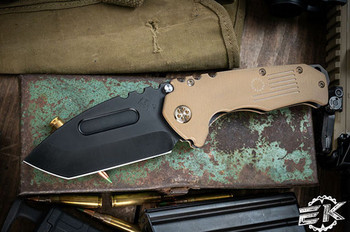Things to Consider Before Buying a Survival Knife
Posted by Clayton on May 16th 2023
There are many features available when buying knives these days. Buyers have too many options. Not all of these options are necessarily good ones, either, especially when buying a survival knife.
Survival knives are one of the most important tools in your gear. Ensuring that you have a good survival knife is critical if you hope to survive in the wilderness. Here are some things to consider when purchasing a survival knife:
Knife Tang
Tang refers to the portion of the blade that extends into the handle of your knife. The blade and tang are a single solid piece of steel. Full tang knives have a tang that extends all the way to the base of the handle. Partial tang knives have blades that only extend partially into the handle or have blades that are just connected to the top of the handle. Full tang is definitely better for a survival knife, because it is stronger and ensures that the blade will not break off.
Knife Handle
There many materials that knife handles are made of, from polymer to hard rubber. In general, most handle materials will be suitable for a survival knife. The main thing to avoid is a knife with a hollow handle. Some survival knives have a hollow handle that allows other survival items, such as matches and twine, to be stored in them. There are many reasons to avoid these knives.
First, the knife will not have the important full tang feature. It will be weaker and more likely to break. You also have to consider the practicality of keeping all of your survival tools in one. If you were to lose your knife, then all of your survival tools would be lost with it. Other things like compasses in the handle should be avoided as well. They will only impair your grip on the knife.
Blade Material
Survival knife blades are made of either stainless steel or carbon steel. Stainless steel is durable and can last long without rusting. Carbon steel typically holds an edge longer than stainless steel, but it is more susceptible to rust. Both are durable and suitable for a survival knife. It comes down to a matter of preference. Consider whether you would rather have a blade that keeps its edge longer or one that takes longer to rust.
Blade Design
Survival knives have either a serrated or a straight edge. A straight blade is better for carving wood and is a lot easier to sharpen in the wild. Typically, you should use a sharpening stone designed to sharpen your blade. However, in the wild, a smooth stone can be used to sharpen a straight edge. In most cases, a serrated edge requires a special sharpener. This is obviously an important aspect to consider when choosing a survival knife.
Blade Length
Survival knives are typically 6 to 12 inches long. A shorter knife is not big enough to fulfill the needs of a survival situation. A longer knife can be too big to handle efficiently and can be more of a handicap than a tool. Keep these in mind when choosing a survival knife. Choose a knife that is long enough to be effective, but not so long that it becomes ineffective.
Blade Thickness
A survival knife should be thick enough that it can effectively withstand the abuse that comes with carving wood and prying. Blades with a lot of flex have their place, and a survival knife is not one of them. Make sure that your knife is very solid with little flex. Normally, 3/16 to 4/16 of an inch is the best thickness for survival knives.
Sheath
The sheath may not seem like an important aspect of the survival knife, but it is. The sheath impacts how you carry your knife and draw it. Typically, you want your sheath to have a belt attachment and a lower attachment so that you can strap your knife (when it is on your belt) to your leg or backpack. It is also best to have a sheath that has a strap that secures the knife in the sheath. This ensures that your knife will not fall out.
Conclusion
There are many things to consider when you are buying a survival knife. You have to make sure the knife is strong enough to cope with any situation, no matter how dire, in order to increase your odds of survival.
Additionally, you want to make sure that the blade material, length, and design all suit survival needs and your personal preferences. In the end, you should choose a knife that you think will be best suited to your individual survival needs.

